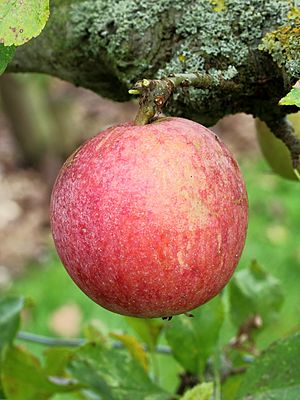Allington Pippin facts for kids
Quick facts for kids 'Allington Pippin' |
|
|---|---|
 |
|
| Genus | Malus |
| Species | M. domestica |
| Hybrid parentage | 'King of the Pippins' x 'Cox's Orange Pippin' |
| Cultivar | 'Allington Pippin' |
| Origin | |
The Allington Pippin is a special type of apple that comes from England. It's known for its strong, unique flavor, which some people say tastes a bit like pineapple!
Contents
Where Does the Allington Pippin Come From?
This apple was first grown before the year 1884. A person named Thomas Laxton developed it in a place called Lincolnshire, England. He created it by crossing two other famous apple types: the Cox's Orange Pippin and the King of the Pippins.
The apple didn't get its name right away. In 1894, a man named George Bunyard officially named it 'Allington Pippin'. He named it after a village called Allington, which was near one of his plant nurseries in Kent.
What's Special About This Apple?
The Allington Pippin apple has a cool, cone-like shape. Its skin is a mix of bright red and orange colors, often with stripes and some rough, brownish patches called russeting.
People love its flavor, which can be mellow, sharp, or even taste like fruit candy or pineapple. This makes it a very useful apple! You can use it for cooking, eat it fresh as a snack, or even make tasty apple cider with it.
The Allington Pippin is also quite a strong apple. It can be stored for three months or even longer, and it holds its shape well when you cook with it.
Growing Allington Pippin Trees
Allington Pippin apple trees tend to have a "biennial bearing" habit. This means they might produce a lot of apples one year and fewer the next. Their flowers bloom in the middle of the growing season, and the apples are ready to pick later in the year.
The trees are generally pretty healthy and don't get too many diseases. However, their blossoms can be sensitive to frost, which means a cold snap could harm the flowers before they turn into apples.
See also
 In Spanish: Allington Pippin (manzana) para niños
In Spanish: Allington Pippin (manzana) para niños

